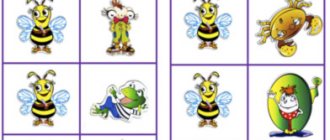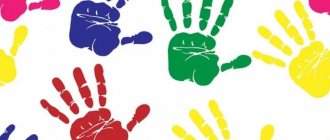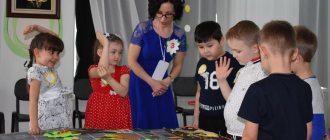How to play finger games?
To achieve the desired result, you need to pay attention to some features of finger games.
- The game should be carried out simply by communicating with the child, and not in the form of a special lesson.
- For children 4-5 years old, regularity of classes is important, i.e. Games should be played not occasionally, but every day.
- The games themselves take a short time (2-5 minutes), but it is important that the child is not distracted by foreign objects or any other external stimuli during the game.
- For children 4-5 years old, finger play can be a way to switch the child’s attention to the game, an option for changing the type of activity.
The importance of finger exercises for the development of preschool children
Finger games and finger gymnastics are a type of children's motor activity, the main goals of which are:
- development of fine motor skills of the hand, palm and fingers;
- improvement and enrichment of tactile sensations;
- development of skills to manipulate small objects and perform actions with them.
Unlike games, finger gymnastics has a clearer, fixed structure, involves performing actions in a certain order, according to the model shown by the teacher, and includes elements of self-massage. But since finger games are exciting, dynamic and have a great influence on the development of the emotional sphere of preschoolers, they can also be used during organized educational activities as a type of light gymnastics for the palms and fingers.
Why are exercises for fingers and palms so useful in preschool age? The well-known phrase by V. A. Sukhomlinsky “The child’s mind is at the tips of his fingers” reveals one of the main goals of these exercises: to promote the development of intelligence, cognitive activity, and curiosity of the baby.
Unlike adults, for children to get a complete understanding of a subject, it is not enough to see it. They need to touch it, try it out, find out whether it is hard or soft, flexible or not, what play actions can be performed with it, whether it makes sounds, whether it is pleasant to the touch. All information received is transmitted from the fingers to the brain, stimulating its increased work. By doing finger gymnastics with the baby, we develop his hands as a tool for active exploration of the world around him.
Tactile sensations received by children with the help of their hands give them no less ideas about the world around them than vision
However, in addition to such an important task, finger gymnastics also pursues a number of other, no less significant:
- Speech development. Teachers and psychologists note that the more a child does exercises to develop fine motor skills, the faster he begins to speak, using complete sentences in his speech, and more actively includes adjectives, verbs, and words to describe the emotional state of himself and those around him.
- Health promotion. There are biologically active points on the palms and fingers, influencing which increases the child’s immunity and resistance to various diseases.
- Improving thinking processes (memory, attention). This is facilitated by the motor exercises themselves, and by the poetic or prose texts that accompany gymnastics.
They note the positive impact of finger exercises on the psyche of children. It calms those who are hyperactive and excitable, and allows kids who are too shy and insecure to open up, feel freer, and more relaxed in a team.
If finger gymnastics brings joy, then it is doubly useful: both for mental development and for the formation of the emotional sphere of the child.
Children's finger games about family
Family
And our family lives: (clap your hands, bang your fists on each other) Two stood at the gate, (bend thumbs) Two Nastya ate buns, (bend index fingers) Two Antons (bend middle fingers) Sitting at home, Two wanted to study , (bend ring fingers) Two are crying in the cradle. (bend little fingers)
My family
How glad I am that I have (raise your hand with your palm facing you, then bend your fingers while listing) a sweet family at home: Dad, Mom, me, sister, Brother - a small boy.
My family
(Fingers are bent one by one, starting with the thumb, then twisted with a fist)
One finger is grandpa, Another finger is grandma, The middle finger is daddy, Well, this one is mommy, The youngest is me, This is my whole family!
Fingers are walking
(Clench and unclench your fists, move your fingers, then bend them one by one on a count)
One, two, three, four, five - The fingers want to take a walk. (Move all fingers at the same time.) The thumb sees the crumb, the index finger sees the accordion. The middle one will have fun, the Nameless one will drink water. The smallest one does not sleep, but looks around him.
Game "Autumn Leaves" for middle preschool age
The variegated leaves swirl beautifully—the children smoothly and leisurely move their brushes left and right;
They lie calmly and quietly on the ground. - slowly lower their hands;
When we walk, there is a rustling noise under our feet - we join our palms, rub one against the other;
As if they want to fly above the earth again. - slowly raise their hands, calmly swing them in different directions.
Games about household chores and responsibilities
I 'm helping my mother
Our son washed the dishes. I washed the mugs, bowls, and knife. He wiped the forks and plates - He ran off to play with the burners. (Perform imitating movements according to the text)
Mom's helpers
(Show movements in accordance with the text)
We are mother's helpers, we will help her. Let's wash all the dishes and tidy up the bed. We'll wash the laundry, hang it up to dry, and in the evening we can all drink tea together!
Washing the dishes
(first hit your fists against each other, perform circular movements with your palm on your palm, then bend your fingers while counting objects)
One, two, three, four, (hit with fists) We washed all the dishes: Forks, bowls, ladles, frying pans and spoons. We washed all the dishes, We just broke the cup, The knife also broke, The salt shaker had a side left. The kettle was broken a little, together they helped mom.
Principles of organizing gymnastics for fingers and palms
When conducting finger gymnastics in the middle group of a kindergarten, the teacher should rely both on the general principles used in organizing the activities of pupils, and on the mental and physiological characteristics of children in the fifth year of life.
The organization of gymnastics is based on the principles:
- Systematic and gradual. Gymnastics classes are held regularly, with gradual complication and mandatory repetition of exercises.
- Comfort and voluntariness. Classes should bring children pleasure and joy, and participation in them is always free, at the request of the children. In order for children to perceive gymnastics with interest and actively participate in it, the teacher uses various techniques: artistic expression; attracting a game character; colorful paraphernalia (bright balls, caps with “portraits” of animals, fairy-tale characters.
- Availability and feasibility. All materials (poems, nursery rhymes, illustrations, pictures) that the teacher uses must be appropriate for the age of the children, be familiar to them, and understandable, so as not to cause hesitation or reduce the dynamism of the game.
- Individual approach. Children of the middle group, unlike the younger and nursery groups, no longer need the teacher to teach them exercises every step of the way, taking the child’s hand in his own and manipulating his fingers. Four-year-olds can easily repeat a movement that is shown to them 1-2 times. But the teacher must keep all the children in sight, and if some of the exercises cause difficulties for some of them, or the children perform them incorrectly, work should be done with such children to reinforce the correct position of the fingers during the exercise. This will help kids in other activities (teach children how to properly hold a spoon, pencil, and manipulate objects in games).
Compliance with these principles will help the teacher carry out this type of activity with the greatest benefit for the kids, in a fun way and at the right pace.
When performing gymnastics for fingers in the middle group, it is necessary to pay attention to the synchronization of movements of both hands, whereas a year earlier children could perform movements (rolling a ball on their palm, “walking” with their fingers along the path) with one hand. To do this, children are taught to perform the movement first with one (right) hand, then with the other, and then with both hands together. Gymnastics includes as many exercises as possible on the interaction of hands: tapping, stroking, patting, connecting fingers in pairs. Actions must be performed either simultaneously, or with both hands alternately, for which sometimes the text must be repeated twice. You cannot limit yourself to performing exercises with one hand.
In the middle group, the teacher is given a new task: to teach children to coordinate the movements of both hands
Games about the child's body
Harmonic
Wall, wall (point to cheeks) Ceiling (forehead), Two steps ("walk" along lips with fingers) And a bell. (nose) - Ring! (press on nose) The owner of the house? - Ring! (press on nose) Is the accordion ready? - Ring! (press on nose) Can we play? (lightly tickle the child)
These are our little eyes. Exactly. (show eyes) These are our ears. Exactly. (show ears) This is the nose, this is the mouth. (show nose, mouth) Back. Here's the belly. (show back, belly) Clap-clap with your hands. (clap your hands) Stomp-stomp with your feet. (stomp your feet) Oh, we're tired, let's wipe our brow! (run your palm over your forehead)
Face
Forest, (point to hair) Glade, (forehead) Hill, (run finger across nose) Pit. (child opens mouth) Break (point finger at chin) Explosion. (lightly tickle the neck)
Game "Centipede" for younger preschoolers
A centipede is walking along an autumn path. - children move in one place with marching steps;
Suddenly drops began to fall from the sky. - tap their fingers on the open palm of the other hand;
Oh, forty paws will get wet!
I don’t want a cold, I’ll go around the puddles in an instant,” they make a small circle, imitating going around a puddle;
I won’t bring dirt home, I’ll shake it off all my paws.
And I stomp into the hole, and I stomp loudly. — they walk in place, raising their legs high, knocking them on the floor.
Games about clothes and dressing up
New thing
Hurry, hurry, hurry, hurry - It’s high time to sew Anya a new dress. Quickly take a needle - And we will sew a new thing! (at the beginning, the hands are clenched, then one finger is extended for each word)
Clothes, shoes, hats
Katya put on the mitten: “Oh, where did my finger go? My finger is missing, it’s gone, I didn’t get into my little house.” (clench her fist) Katya took off her mitten: (unclench all fingers except the thumb) “Look, I found it! (bend your thumb) You search, you search and you find, (clench your fingers into a fist, bend your thumb) Hello, little finger, how are you doing?”
Shoes
1. One, two, three, four, five. You need to count the shoes: One - shoes, (bend your fingers one by one) Two - boots, Three - boots, Four - sandals And, of course, slippers - five. Your legs need to rest.
Like our cat
(bend one finger at a time, starting with the thumbs, on both hands together, counting each name of shoe)
Like our cat has BOOTS on her paws. Like our pig has BOOTS on his feet. Like a dog has green slippers on its paws. And the little goat puts on his felt boots. And Vovochka’s son has new SNEAKERS. Like this. Like this. (clap) New sneakers.
Let's count the shoes together and play slowly. (clap your hands and hit the table with your fists, then bend one finger at a time when listing the shoes) Shoes and slippers of My beloved mother, Shoes and boots of Our Serezhenka, And small felt boots of Our Little Varenka.
Boots
Oh, the two of us go everywhere inseparably. (use the middle and index fingers to “walk” on the table) We walked through the meadows, Along the river banks, And ran down the stairs, We walked into the distance along the street, We crawled under the bed, (bend our fingers one at a time) To sleep there quietly. (put your palms on the table)
“Autumn has come” - a game for a middle preschool group
Gloomy autumn has come,
It brought cold rain. - children tap the fingers of one hand on the palm of the other;
The garden suddenly turned yellow,
The wind ruffled the leaves. - rubbing one palm against the other;
You can't hear bird songs,
We will wait until spring for them. - move the brushes up and down.
Game “What do we wear in the fall?” for older group
When getting ready to go for a walk, children connect each right finger with the big left one;
We put on clothes. - combine each left finger with the right thumb;
T-shirt, pants - connect each right finger to the left little finger;
Jacket, scarf, coat. - combine each left finger with the right little finger.
"Birds Fly Away" for older preschoolers
Autumn walks on the ground - the pupils touch the horizontal surface with their right fingers one by one;
For the whole winter until spring - touch with left fingers;
Flocks of birds fly away: - touch again with their right fingers;
Starlings, ducks, blackbirds,
Larks, nightingales. - touch with left fingers again.






